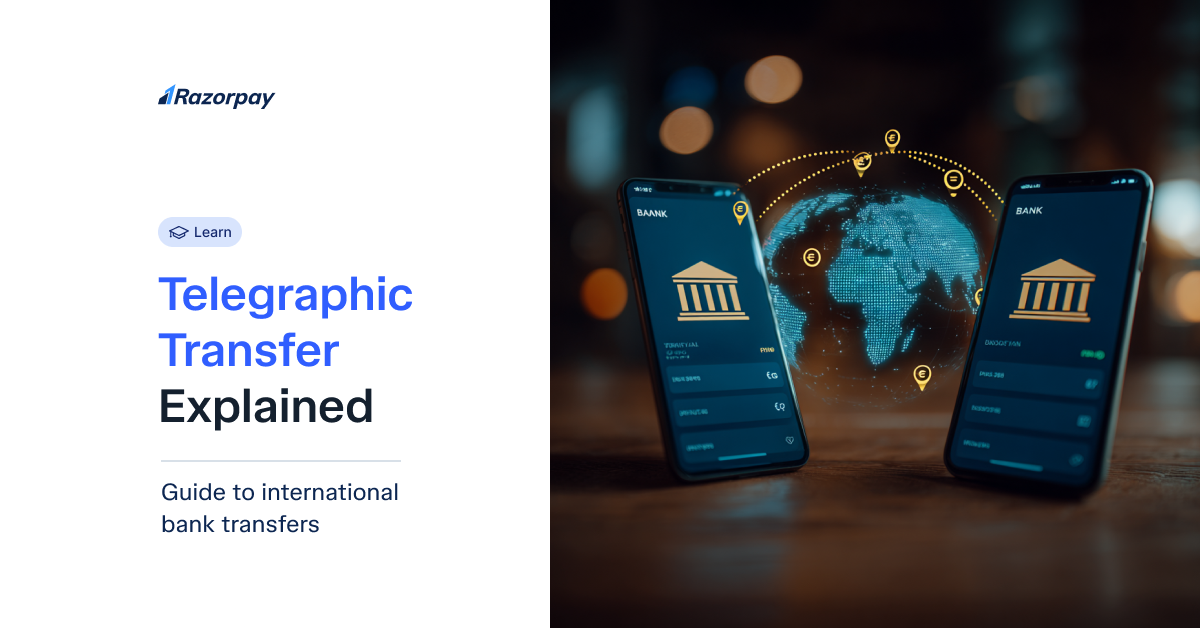When it comes to transferring large sums of money overseas, especially for business or education purposes, Telegraphic Transfer (TT) remains a popular and secure method. Often referred to as a wire transfer, TT allows you to send funds electronically across borders via banks or financial institutions. In this blog, we’ll explore what a Telegraphic Transfer is, how it works, the process, required information, types, benefits, fees, and how it compares to other payment methods.
About Telegraphic Transfer
A Telegraphic Transfer (TT) is an electronic method of transferring funds from one bank account to another, typically used for international payments. Though historically it involved sending payment instructions via telegraph or telex, today it operates through secure electronic networks like SWIFT. Also known as a wire transfer or SWIFT transfer, TTs are widely used by businesses, educational institutions, and individuals for purposes like paying suppliers, tuition fees, or supporting family members abroad.
Information Required for Telegraphic Transfer
To initiate a Telegraphic Transfer (TT) smoothly, ensure you have the following details ready. Providing accurate information is crucial to avoid processing delays or failed transfers:
- Beneficiary’s full name (as per bank records)
- Beneficiary’s bank name and branch address
- SWIFT/BIC code of the beneficiary bank (for international routing)
- Beneficiary’s account number or IBAN
- Currency to be transferred and the exact amount
- Purpose of remittance (e.g., business payment, tuition fees, family support)
- Sender’s full name, account number, and bank name
Double-check all details before submission to ensure a successful transaction.
Why Is It Called Telegraphic Transfer?
The term “Telegraphic Transfer” dates back to when banks used telegraph or telex systems to send payment instructions between countries. These methods enabled banks to communicate swiftly across vast distances, making international trade more efficient.
- Telegraph System: Used in the early 1900s for relaying payment messages.
- Telex Machines: Later replaced telegraphs and were faster and more secure.
Although technology has evolved and transfers are now done electronically, the name “Telegraphic Transfer” has remained in common use globally.
Process of Initiating Telegraphic Transfer
Here’s a step-by-step guide to sending a TT:
Step 1: Gather required information
Collect essential beneficiary details such as their full name, bank account number, bank name, branch address, and the SWIFT/BIC code. You may also need the purpose of remittance and supporting documents.
Step 2: Log in to your online banking or visit your local bank branch
Access your internet banking portal or head to your bank branch, depending on the facilities offered by your bank for international transfers.
Step 3: Fill in the remittance form with accurate details
Complete the telegraphic transfer form by entering all beneficiary and payment details correctly. Any errors can lead to delays or failed transfers.
Step 4: Choose the currency and enter the transfer amount
Select the currency in which the beneficiary will receive the funds and specify the exact amount you want to send.
Step 5: Review and confirm transfer charges and exchange rates
Carefully check the applicable fees, bank commissions, and exchange rate before proceeding. This helps avoid unexpected deductions or currency losses.
Step 6: Submit the transfer request and note the transaction reference
After reviewing all the details, submit your request. Your bank will generate a transaction reference number which you should keep for tracking and record-keeping.
Step 7: Track the transfer through your bank’s online portal or customer support
Monitor the status of your transfer using your bank’s tracking tools or reach out to customer support for updates until the funds reach the beneficiary.
Types of Telegraphic Transfer
Here are the main types of Telegraphic Transfers:
- Inward Telegraphic Transfer
This involves receiving funds from an overseas sender into a local bank account. It’s commonly used for receiving salaries, international remittances, or export payments.
- Outward Telegraphic Transfer
This refers to sending money from a local account to a beneficiary overseas. It’s often used by individuals or businesses for tuition fees, vendor payments, or personal remittances.
- Same-currency Telegraphic Transfer
In this type of TT, the currency remains the same throughout the transfer—no conversion is involved. It’s typically faster and avoids exchange rate fluctuations.
- Cross-currency Telegraphic Transfer
Here, the funds are converted from one currency to another before reaching the beneficiary. It involves exchange rates and may incur additional fees.
Pros of Telegraphic Transfer
Telegraphic Transfers offer several benefits:
- Fast and Reliable
Most Telegraphic Transfers are processed within 1 to 5 business days, making them a preferred choice for urgent payments across borders.
- Global Reach
Since TTs are supported by banks worldwide, they allow individuals and businesses to send or receive money nearly anywhere in the world.
- Secure Transactions
TTs are routed through encrypted and regulated networks like SWIFT, ensuring a high level of transaction security and protection against fraud.
- Trackable
Once initiated, TTs can be tracked via bank portals or customer support, with reference numbers and confirmations that provide peace of mind.
Run a business in Singapore?
Razorpay Singapore offers a secure, easy-to-use payment platform that helps you accept payments online via cards, e-wallets, PayNow, and more— backed by trusted local partners and global payment capabilities.
Cons of Telegraphic Transfer
Despite the benefits, TTs have some drawbacks:
- High Fees
TT costs can include sending bank fees, correspondent/intermediary bank charges, and receiving bank fees—making it costly for smaller transactions.
- Exchange Rate Fluctuations
The exchange rate applied at the time of processing may differ from what was expected, which can impact the final amount received.
- Processing Delays
Transfers involving rare currencies or banks in remote locations may take longer than usual, sometimes exceeding the standard 5-day window.
- Limited Recourse
If incorrect beneficiary details are entered, reversing or recovering the funds can be difficult, costly, or even impossible in some cases.
What is the Difference Between Telegraphic Transfer and Wire Transfer
| Feature |
Telegraphic Transfer |
Wire Transfer |
| Terminology |
Common in Asia |
Common in Western countries |
| Technology |
SWIFT, electronic networks |
SWIFT, Fedwire, CHIPS |
| Purpose |
Cross-border payments |
Both domestic and international |
| Cost |
Varies; can be high |
Varies by provider and method |
| Speed |
1–5 business days |
1–3 business days |
|
Institutions Used |
Banks, licensed money remitters |
Banks, digital payment providers |
Up-to-Date Charges: Comparing TT Fees Across Singapore Banks
| Bank |
Processing Fee |
Handling Fee | Intermediary Fees |
FX Markup |
| DBS |
S$10–S$35 |
S$20 | Varies |
~1.5–2% above mid-rate |
| UOB |
S$20–S$40 |
S$20 | Varies |
~1.5–2.5% |
| OCBC |
S$20 |
S$10 | Varies |
~1.3–2.2% |
| Digital Platforms |
Lower or Zero |
Minimal | Often waived |
Competitive rates |
- Online vs. OTC: Online transfers are generally cheaper than over-the-counter.
- Recipient Charges: May apply depending on the receiving bank.
- Pro Tip: Compare platforms to reduce costs.
How Long Does a TT Transfer Take?
Telegraphic Transfers usually take 1 to 5 business days to complete. Timing depends on:
- Recipient’s Country and BankTransfers to major banks in well-connected countries are usually quicker, while rural or less-developed regions may experience delays.
- Currency Being TransferredCommon currencies like USD, EUR, or GBP are processed faster. Less common or exotic currencies may require additional time for conversion and clearance.
- Number of Intermediary BanksIf the transfer passes through multiple correspondent banks, each may add to the overall processing time, especially if one experiences delays.
- Bank Processing Cut-Off TimesEach bank has a daily cut-off time for processing transfers. Requests made after this time are typically handled the next business day.
- Public Holidays in Either CountryNational or bank holidays can pause processing, extending the transfer timeline—especially if they fall on consecutive days in different countries.
For faster alternatives, digital money transfer services or fintech platforms may offer quicker delivery—sometimes within minutes—depending on the destination and amount.
Security & Compliance: Understanding MAS Regulations for Telegraphic Transfers
In Singapore, the Monetary Authority of Singapore (MAS) plays a key role in safeguarding the integrity of financial transactions, including Telegraphic Transfers (TTs). MAS enforces strict compliance protocols to ensure all transfers are legal, secure, and transparent. These include:
- Anti-Money Laundering (AML) ChecksBanks and remittance providers must screen every transaction to detect and prevent illicit fund movement, protecting the financial system from abuse.
- Countering the Financing of Terrorism (CFT)Financial institutions are required to monitor transfers for links to terrorism financing and report any suspicious activity to authorities.
- Know Your Customer (KYC) RequirementsBefore processing a TT, banks must verify the sender’s and recipient’s identities through official documents and background checks to prevent fraud.
Licensed providers must continuously monitor transactions, maintain detailed records, and report red flags to MAS. These regulatory measures ensure that Telegraphic Transfers remain compliant, secure, and trustworthy for both individuals and businesses.
Conclusion
Telegraphic Transfers (TTs) continue to be a trusted and widely used method for sending money across borders—ideal for high-value transactions in business, education, or personal remittances. Despite some drawbacks like higher fees and processing times, TTs offer unmatched security, traceability, and acceptance worldwide. As with any financial transaction, it’s important to double-check all details, stay informed about exchange rates and charges, and compare service providers to ensure the best combination of speed, cost-efficiency, and reliability.
FAQs
1. Is a telegraphic transfer the same as a bank transfer?
Not exactly. While a telegraphic transfer is a type of bank transfer, not all bank transfers are telegraphic transfers. TTs are specifically used for international fund transfers.
2. Are there any limitations on the amount that can be transferred via telegraphic transfer?
Limits vary by bank and country regulations. Some banks may set daily limits or require additional documentation for high-value transfers.
3. How do exchange rates affect telegraphic transfer and how can I get the best rate?
Exchange rates influence the final amount received. Compare banks and digital platforms to find the best FX rates and avoid excessive markups.
4. What is the information required for both the sender and receiver to complete the telegraphic transfer?
You’ll need names, bank account details, SWIFT/BIC codes, transfer amount, currency, and purpose of payment.
5. What are the common mistakes to avoid when sending a telegraphic transfer?
Providing incorrect bank details, ignoring exchange rate fees, or missing bank cut-off times can delay or fail a transfer. Always verify details before submitting.




